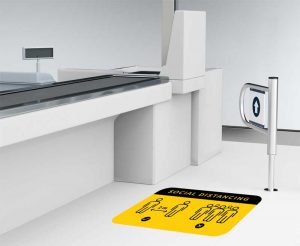
Over the course of 10 days in May 2020, FD Signs in London, U.K., printed, finished, and delivered approximately 100,000 social distancing floor graphics for installation by 30 different teams in London Underground, railway stations, and tram stops.
Trips are another essential consideration for floor graphics. Trip hazards can be minimized by using specialist floor graphics media, as these products will have been developed to adhere securely to most typical floor surfaces without tearing or curling at the edges. They may have been engineered to withstand heavy foot traffic, high-heeled shoes, and machinery without being damaged. They should also be removed easily and cleanly without leaving a sticky residue, which itself could pose a tripping risk.
Fire ratings are also important. Ensure all products used in a public space have achieved a sufficient fire safety certification.
The manufacturer or supplier of the selected floor graphics product will be able to explain the slip and fire ratings and offer advice to ensure the right media is selected for the specific environment.
Choose the right product for the conditions
There is a wealth of floor graphics products available, each with different bonding qualities and durability under different conditions. Therefore, it is important to look at other aspects besides certifications to ensure safety. In addition, floor graphics that are used to convey a message—safety instructions or directions, for instance—must have resistance against colour fade, loss of ink adhesion, and abrasions and scratches.
There are two types of floor graphics media. One-part products are designed to be ‘print and go’—print and finish (on the same machine, if a combination printer/cutter is used) then install, in a quick, labour-saving process. However, unlaminated one-part graphics are not ideally suited to eco-solvent inks as the ink may rub off. They are also not designed for high-traffic areas.

Trip hazards can be minimized by using specialist floor graphics media, as these products will have been developed to adhere securely to most typical floor surfaces without tearing or curling at the edges.
Two-part solutions combine a print media product and a laminate film. Naturally, production times take longer compared to a one-part solution, including drying and degassing times for eco-solvent inks and cutting having to take place after printing and laminating. Suppliers will also need a laminator as well as a printer. However, two-part solutions offer better durability in high-traffic areas and improved scratch-and-abrasion resistance than one-part products, even enduring industrial cleaning and buffing machines.
Another benefit of the two-part approach is the ability to mix-and-match the print media and the laminate to create the perfect product. For instance, a film with a high coat-weight adhesive should be used with ultraviolet (UV) inks as it can cover its peaks and troughs to create a stronger bond between the printed surface and the laminate. There are also more options for the surface texture, to give varying levels of slip resistance.
In short, if the project requires graphics to be installed quickly and easily, for a short duration in a low-traffic area, a one-part product is an effective and affordable answer. For long-term floor graphics in high-traffic areas, perhaps with trickier ink types, and if the client accepts a slightly longer lead time, a two-part solution will be a better investment.





